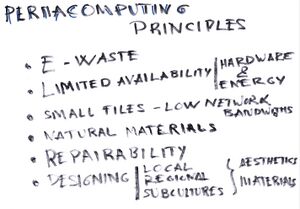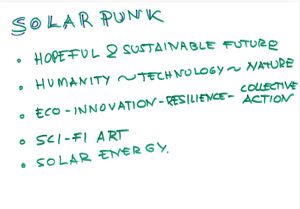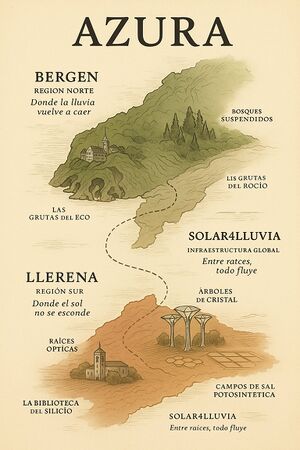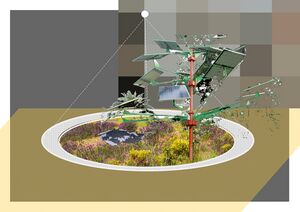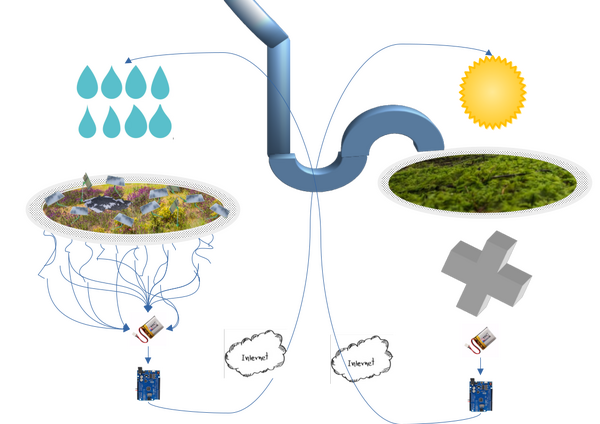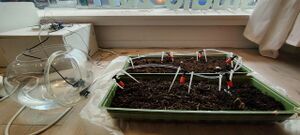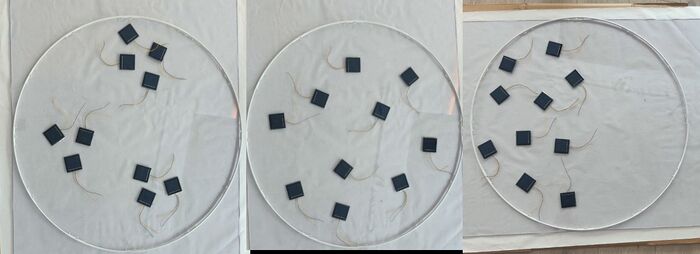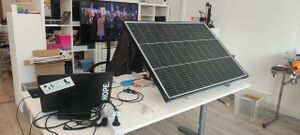Solar4Rain: Difference between revisions
No edit summary |
|||
| (8 intermediate revisions by 2 users not shown) | |||
| Line 3: | Line 3: | ||
''' | ''' | ||
[[File: | [[File:LOGO-1.jpg|thumb|alt=Solar4Rain Logo Permaculture SolarPunk|Solar4Rain Logo Permaculture SolarPunk]] | ||
== '''Introduction''' == | == '''Introduction''' == | ||
| Line 43: | Line 43: | ||
- Rearranging the room | - Rearranging the room | ||
- Gisle started doing some [[pipeline research]] | - Gisle started doing some [[pipeline research]]🌍 (powered by DeepSeek) | ||
===April 20. At the cabin=== | ===April 20. At the cabin=== | ||
We started to prompt ChatGPT to expand Solar4Rain into a tale based on Ursula K. Le Guin style. This is what we got. It | We started to prompt ChatGPT to expand Solar4Rain into a tale based on Ursula K. Le Guin style. This is what we got. It really impressed us. | ||
Solar4Rain [[A short solarpunk novel in the spirit of Ursula K. Le Guin]] | |||
[[🌍 MAPA CONCEPTUAL DEL MUNDO DE AZURA - SPANISH]] | |||
[[🌍 CONCEPTUAL MAP OF AZURA - ENGLISH]] | |||
[[File:Solar4Rain-map.jpg|thumb|alt=Solar4Rain-map, and AI generated image based on the project prompt and in te style of Ursula Le Guin maps|Solar4Rain-map, and IA generated image based on the project prompt and in the style of Ursula Le Guin maps]] | |||
===May 4. Brain storming day=== | |||
Some ideas start to pop up. | |||
Gisle is suggesting to work with real pipes and connect them to the water pipe collecting the rain in Bergen. | |||
We thought to have different sizes of pipes to represent the variety of pipes we will find on our way, from Bergen to Llerena. | |||
===May 5. Explorations=== | |||
We also have the idea to use slime mold to get the best way to send the water from Bergen to Llerena. Need more experimenting with it. | |||
Maite has been working on how to print the Miyamoto Tower in the Prusa Mini+ Here I can get the STL file but no idea how to implement it. https://origamisimulator.org/ | |||
and also on how to make a cube that can hold the small solar panels we have. | |||
===May 6. Explorations=== | |||
Maybe we have a plan: To make 2 circular platforms with plants from Bergen and Llerena, to hung them on a kind of plate and use another hanging plate to install the led light on the top. We can use a central tower with both the rain and the solar cells OR to separate the towers. Spatial design. | |||
[[File:Plate-3Dmap-Llerena-solartree.jpg|thumb|alt=Plate-3Dmap-Llerena-solartree|Plate-3Dmap-Llerena-solartree]] | |||
[[File:Solar4Rain-setup-draft.png|600px|alt=Solar4Rain-setup-draft|Solar4Rain-setup-draft]] | |||
===May 9. Explorations=== | |||
We keep testing basic elements, the water pump, the drippers, etc | |||
Also started with the solar panels, Gisle mounted the big one we have, I am starting to work with the small ones bought in China. | |||
We also put the Prusa to work a bit. Is cool. | |||
As part of the permacomputing principles we are recycling everything we can and working with materials we have. It is surprising how many things we could have been storing :) | |||
Got the plexiglass, and it looks like a good idea to use it. | |||
Here some images from today: | |||
[[File:Photo_1_2025-05-09_18-36-01.jpg|thumb|alt=Water dripping system connected with an Arduino Uno|Water dripping system connected with an Arduino Uno]] | |||
[[File:Solar-panels-plexiglass.jpg|700 px|alt=Solar-panels-plexiglass-design|Solar-panels-plexiglass-design]] | |||
[[File:Photo 3 2025-05-09 18-36-02.jpg|thumb|alt=Solar panel|Solar panel]] | |||
[[File:Photo 7 2025-05-09 18-36-02.jpg|150px |thumb]] | |||
Latest revision as of 17:11, 9 May 2025
Solar4Rain
Introduction
Solar4Rain, an atmospheric PUNK symbiosys Solar4Rain is an interdisciplinary art project that employs the metaphor of the life cycle—sun and rain—as a lens to explore macroeconomic and geo-global dynamics. By examining the interplay of resources such as water and solar energy, the project critically addresses the growing tensions between resource-rich regions and the inequities perpetuated by climate change and exploitative practices. It highlights pressing issues such as neo-colonialism in renewable energy, the geopolitics of water, and the ethical challenges of global resource management. Through an engaging sci-fi narrative, the project envisions a speculative future where humanity adopts equitable, sustainable, and symbiotic relationships with nature and technology.
At its core, Solar4Rain aims to expose the paradoxes inherent in renewable energy exploitation. For example, Norwegian investments in Spanish photovoltaic farms generate significant profits but fail to contribute to local economies through taxation, while land acquisitions in Africa, Spain and Norway by external/international investors are driven by the pursuit of water resources, exacerbating existing inequalities. The project seeks to provoke reflection on these systemic imbalances and inspire audiences to question the structures that underpin global resource extraction and exchange. By presenting an alternative vision, it fosters dialogue on how these systems can be reimagined for a more equitable and sustainable future.
To achieve this, the project integrates multiple artistic strategies, including data visualization, speculative storytelling, and audience participation. Through immersive installations, visitors will encounter interactive displays that use light, sound, maps, and simulated contracts to illustrate the interconnectedness of global resource systems and their inequities. A central sci-fi narrative imagines a world where balanced resource distribution and ethical cooperation prevail, blending the principles of Solar Punk and permacomputing. The public is also invited to participate in experimental labs, where they can co-create and propose new systems of exchange, actively contributing to a shared vision of resilience and collaboration.
Daily blog
April 15
- We decided to do everything something that can be visible
- To start this daily blog
- We went through the principles of Permacomputing and Solarpunk
- We revise all our notes
- Maite installed the microscope and software - to see how is the water here...
- Gisle started with the 3d printing
April 16
-Gisle doing some test 3D prints
-Maite made some microscope videos of Bergen water
April 17
- Rearranging the room
- Gisle started doing some pipeline research🌍 (powered by DeepSeek)
April 20. At the cabin
We started to prompt ChatGPT to expand Solar4Rain into a tale based on Ursula K. Le Guin style. This is what we got. It really impressed us.
Solar4Rain A short solarpunk novel in the spirit of Ursula K. Le Guin
🌍 MAPA CONCEPTUAL DEL MUNDO DE AZURA - SPANISH
🌍 CONCEPTUAL MAP OF AZURA - ENGLISH
May 4. Brain storming day
Some ideas start to pop up.
Gisle is suggesting to work with real pipes and connect them to the water pipe collecting the rain in Bergen.
We thought to have different sizes of pipes to represent the variety of pipes we will find on our way, from Bergen to Llerena.
May 5. Explorations
We also have the idea to use slime mold to get the best way to send the water from Bergen to Llerena. Need more experimenting with it.
Maite has been working on how to print the Miyamoto Tower in the Prusa Mini+ Here I can get the STL file but no idea how to implement it. https://origamisimulator.org/ and also on how to make a cube that can hold the small solar panels we have.
May 6. Explorations
Maybe we have a plan: To make 2 circular platforms with plants from Bergen and Llerena, to hung them on a kind of plate and use another hanging plate to install the led light on the top. We can use a central tower with both the rain and the solar cells OR to separate the towers. Spatial design.
May 9. Explorations
We keep testing basic elements, the water pump, the drippers, etc
Also started with the solar panels, Gisle mounted the big one we have, I am starting to work with the small ones bought in China.
We also put the Prusa to work a bit. Is cool.
As part of the permacomputing principles we are recycling everything we can and working with materials we have. It is surprising how many things we could have been storing :)
Got the plexiglass, and it looks like a good idea to use it.
Here some images from today:

